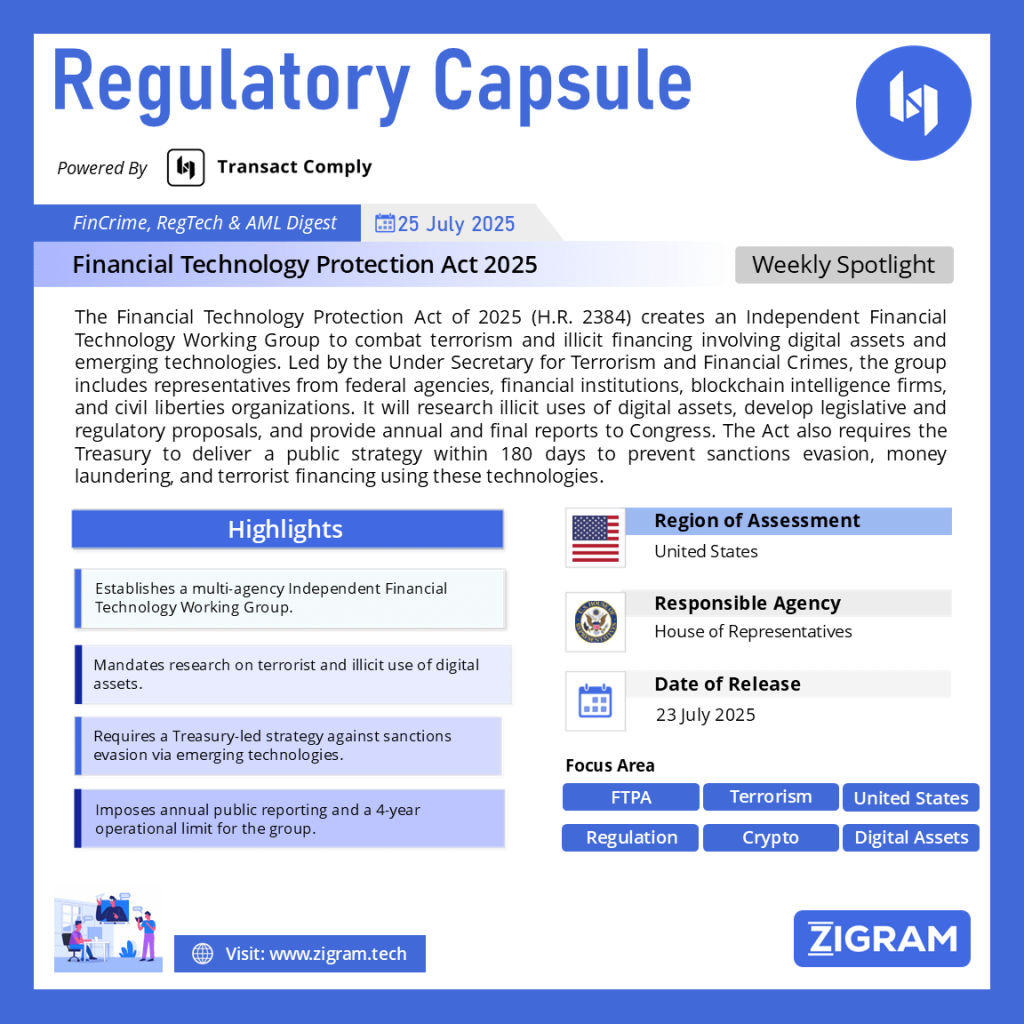Regulation Name: Financial Technology Protection Act 2025
Date Of Release: 23 July 2025
Region: United States
Agency: House of Representatives
Financial Technology Protection Act of 2025: Strengthening the U.S. Framework Against Terrorist and Illicit Financing
The Financial Technology Protection Act of 2025 (H.R. 2384) represents a major U.S. legislative initiative aimed at addressing the challenges posed by digital assets and emerging technologies in the context of terrorist financing, sanctions evasion, and other illicit activities. Introduced by Rep. Zach Nunn (R-IA) and Rep. Jim Himes (D-CT) and reported with amendments by the House Committee on Financial Services, the bill seeks to create an integrated, multi-agency response to financial crimes leveraging new technologies.
Establishment of the Independent Financial Technology Working Group
At the core of the legislation is the creation of the Independent Financial Technology Working Group to Combat Terrorism and Illicit Financing. This multi-stakeholder group is tasked with:
Researching terrorist and illicit uses of digital assets and related technologies
Developing legislative and regulatory proposals to strengthen anti-money laundering (AML) and counter-terrorist financing (CTF) measures .
The Working Group is chaired by the Under Secretary for Terrorism and Financial Crimes and includes senior-level representatives from:
The Department of the Treasury (including the Office of Terrorism and Financial Intelligence and the IRS)
Department of Justice, FBI, DEA, Homeland Security, Secret Service, and the Department of State
The Office of the Director of National Intelligence .
Additionally, at least five experts from the private sector—covering fintech companies, blockchain intelligence firms, financial institutions, research organizations, and privacy advocacy groups—will be appointed to ensure a balanced perspective .
Objectives and Responsibilities
The Working Group’s mandate extends beyond research. It will:
Assess threats from State and non-State actors using digital assets for illicit purposes.
Recommend policy actions for U.S. agencies to counter these threats.
Facilitate public-private collaboration to bridge gaps in AML/CTF oversight within the rapidly evolving financial technology sector.
The group is required to submit annual reports for three years following the Act’s enactment and provide a final report before it terminates, summarizing research findings, recommendations, and proposed regulations.
Combating Sanctions Evasion Through Digital Assets
Section 3 of the Act mandates a comprehensive report and strategy from the President, through the Treasury Department, within 180 days of enactment. This strategy will outline:
How States, foreign terrorist organizations, and criminal networks exploit digital assets (e.g., cryptocurrencies) and other emerging technologies to evade sanctions, launder funds, and finance terrorism.
Steps the U.S. will take to prevent such illicit activities, including potential regulatory and enforcement enhancements .
Importantly, the report must be unclassified and publicly accessible, with a classified annex as necessary . This transparency ensures public awareness of the government’s approach to digital financial threats.
Key Definitions in the Act
To ensure clarity, the Act defines critical terms, including:
Digital Asset – Any digital representation of value recorded on a cryptographically secured ledger .
Emerging Technologies – As identified by the National Science and Technology Council’s Critical and Emerging Technologies List.
Illicit Use – Encompassing fraud, darknet transactions, money laundering, sanctions evasion, and other unlawful activities.
Blockchain Intelligence Company – Entities providing services like blockchain tracing, sanctions screening, and transaction monitoring .
Reporting and Sunset Provisions
The Working Group has a four-year lifespan, after which it will be dissolved unless ongoing research requires temporary continuation. Any remaining funds at termination will be returned to the Treasury .
Additionally, the Treasury Secretary must brief Congress within two years on the implementation of the digital asset strategy .
Implications for AML/CFT Frameworks
This Act comes at a critical time when digital currencies and decentralized technologies are increasingly exploited by rogue actors. By combining government expertise with private-sector innovation, the Financial Technology Protection Act:
Enhances cross-agency coordination in detecting and disrupting illicit financial flows.
Strengthens regulatory foresight for emerging fintech trends.
Creates a publicly accountable mechanism for addressing terrorism financing in the digital era.
For AML/CFT professionals, this bill signals a proactive shift in U.S. policy—from reactive enforcement to anticipatory regulation and collaborative threat analysis.
In conclusion, the Financial Technology Protection Act of 2025 sets a new precedent for how governments can balance innovation, national security, and civil liberties in managing the financial risks of emerging technologies. By institutionalizing dialogue between the public and private sectors, it aims to safeguard the integrity of the financial system while addressing one of the most pressing challenges of our time: the illicit use of digital assets.
Read the full act here.
Read about the product: Transact Comply
Empower your organization with ZIGRAM’s integrated RegTech solutions – Book a Demo
- #FinancialTechnologyProtectionAct2025
- #DigitalAssets
- #AMLCFT
- #Crypto

